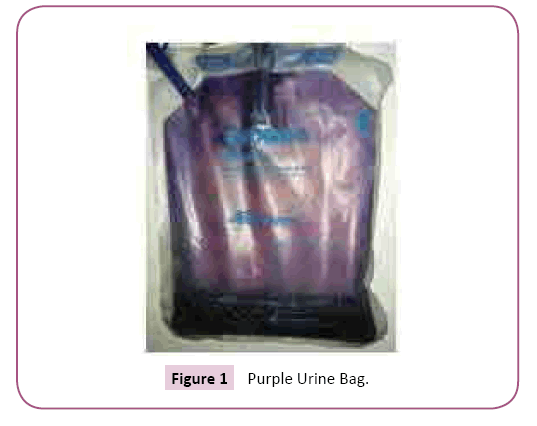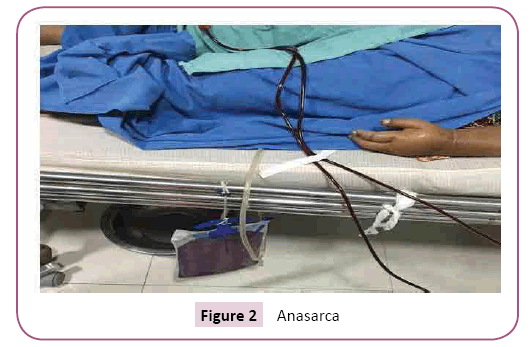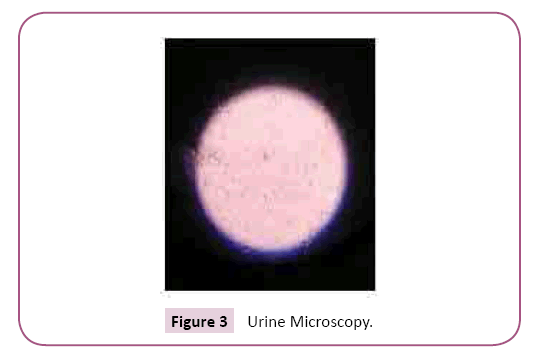Upma Narain1* and Arvind Gupta2
1Microbiologist & Immunologist, Tejas Microdiagnostics, Allahabad, Uttar Pradesh, India
2Professor, Division of Nephrology, Moti Lal Nehru Medical College, Allahabad, Uttar Pradesh, India
- *Corresponding Author:
- Upma Narain
Tejas Microdiagnostics 62
Jawahar Lal Nehru Road, Tagore Town
Allahabad, Uttar Pradesh-211002, India
Tel: +91-9415253337
E-mail: upmanarain@gmail.com
Received Date: November 15, 2019; Accepted Date: November 27, 2019; Published Date: December 04, 2019
Citation: Narain U, Gupta A (2019) A purple urine bag syndrome in a CKD patient. Arch Clin Microbiol Vol. 10 No. 4:97
DOI: 10.36648/1989-8436.100097
Keywords
Purple urine bag; CKD; Heamodialysis; Proteus mirabilis; UTI
Introduction
Purple urine bag syndrome (PUBS) refers to purple discoloration of the urinary drainage bag occurring in patients on long-term urinary catheterization (Figure 1). It is a rare manifestation associated with urinary tract infection caused by bacteria that produce sulfatase or phosphatase. This phenomenon results from bacterial fermentation of indoxyl sulfate (indican) to indigo and indirubin, which then dissolves in the plastic of urine bags [1].

Figure 1: Purple Urine Bag.
Female gender, constipation, urinary tract infection, dementia, alkaline urine, high urinary bacterial counts and iron deficiency anemia are associated with PUBS. Most studies have reported that PUBS is benign, harmless, and even asymptomatic, but it can be associated with significant morbidity and mortality [2]. Treatment should be aimed at the underlying medical problem rather than at PUBS itself. We present an interesting case of an elderly diabetic, hypertensive and CKD stage 5 D+ woman who had a purple colored urine bag. To the best of our knowledge, this is the first case of PUBS reported from Uttar Pradesh.
Case Report
On 28th March 2019 a 58 year old female was admitted to the hospital with high grade fever, oedema, respiratory distress with her urine bag turning blue two days back. The woman was previously diagnosed with CKD resulting from diabetic nephropathy and also had a positive history of hypertension. She suffered a fracture to her left femur 2 months back following which she was catheterized and the catheter was not removed. At the time of admission, physical examination revealed BP- 210/110 mm Hg, saturation 86%, temperature 100°F, pulse, anasarca and gross oedema (Figure 2).

Figure 2: Anasarca
Blood samples were sent immediately to the laboratory for testing and laboratory findings are depicted in the Table 1 and urine routine microscopy is illustrated in Figure 3.

Figure 3: Urine Microscopy.
Table 1 Laboratory findings of the patients before and after haemodialysis.
| Investigations |
Day 1 |
Day 3 |
Day 5 |
| S. PCT (ng/ml) |
4.2 |
2 |
0.8 |
| TLC (Cells/cumm) |
22000 |
13000 |
8200 |
| DLC |
P: 90, L: 08, |
P: 76, L: 16, |
P: 69, L: 24, |
| M: 01, E: 01 |
M: 6 , E: 02 |
M: 05, E: 02 |
| S. Urea (mg/dl) |
200 |
100 |
94 |
| S. Creatnine (mg/dl) |
9 |
4 |
4.5 |
| S. Na (mmol/L) |
141 |
138 |
136 |
| S. K (mmol/L) |
6.72 |
4 |
3.5 |
| S. Calcium |
1.3 |
|
1.3 |
| Urine C/S |
|
Proteus mirabilis |
|
| Blood C/S |
|
|
Sterile |
Antibiotics Tegicycline 50 mg bd, Meropenam 1 gm bd, human insulin infusion Actrapid, Nifedipine 20 mg tds, Moxanidine D2 tds and Carvedilol-CR 20 mg started immediately along with supportive therapy. After an hour of admission she was put on haemodialysis with ultra-filtration of 3 lit with F-6 to get relief of breathlessness and oedema. Patient tolerated dialysis session very well.
On day 3 urine culture report shown the growth of proteus mirabilis with colony count of 1,20000 CFU/ml.
Discussion
The first case of PUBS was described in 1978 [3] by Barlow and Dickson. They also stated that these risk factors were quite common in pediatric patients with spina bifida and urinary diversion.4 In terms of frequency, its prevalence has been reported as high as 27% in a Korean geriatric hospital and about 7.5% in an Italian general hospital. Out of these, 73% were females, and were all over 65 years of age.
King George III had blue urine during a bout of chronic constipation [4]. PUBS is a consequence of UTIs with bacteria which metabolise products of tryptophan to produce red and blue pigments. Normal bacterial flora deaminates tryptophan in the gastrointestinal tract to produce indole. Indole is rapidly transported by the portal circulation and is conjugated to produce indoxyl sulphate by the liver. This is secreted into urine where sulphatases and phosphatases produced by certain bacteria convert it to indoxyl. In alkaline urine especially, indoxyl is oxidised to indigo and indirubin. These pigments mix and react with catheter tubing to produce a striking purple hue. This interaction between the bag and pigments as well as a high bacterial load is important in precipitating PUBS [5].
In patients with CKD, the serum concentration of indoxyl sulfate had a linear correlation with the severity of azotemia. The intestinal flora is deranged in uremic patients due to an increase in the concentration of aerobacteria such as Escherichia coli and a relative decrease in the concentration of anaerobacteria such as bifidobacteria [6]. Because indole (the precursor of indoxyl sulfate) is chiefly produced by the aerobes, its accumulation in the intestine is due to their overgrowth as compared to that of the anaerobes. Therefore, the increased serum concentration of indoxyl sulfate in uremic patients may increase the quantity of urinary indoxy sulfate. Since it is bound to plasma albumin, Indoxyl sulfate removal during dialysis is limited there-fore, oral adsorbent coupled with a low-protein diet can decrease the serum and urine levels of indoxyl sulfate along with changing the urinary catheter and urinary bag in uremic patients [7]. Although this condition is often easily treated with antibiotics, we must bear in mind that diagnosing PUBS in chronic renal patients probably reflects an increased serum and urinary concentration of indoxyl sulfate, and that this uremic toxin is involved not only in the progression of CKD, but also in that of cardiovascular disease in chronic renal patients. The measures taken in our case were the replacement of Foley’s catheter followed by hemodialysis which resulted in immediate relief to the patient. The patient was then put on a low protein diet along with oral adsorbents. Hypoglycemic episodes may be severe in patients with renal failure, and the drugs Sulfonylures are contraindicated from stage 3 of CKD [8,9]. Hence we did not use the same.
In our case, the pathogen isolated was Proteus mirabilis. The most common bacteria however, that are associated with PUBS include Providencia stuartii, Providencia rettgeri, Klebsiella pneumoniae, Proteus spp., Escherichia coli, Enterococcus spp., Morganella morganii, and Pseudomonas aeruginosa while the bacteria that are least commonly associated are Citrobacter spp., Staphylococcus spp., Streptococcus spp. and Methicillin-resistent Staphylococcus aureus [10].
Conclusion
It is noteworthy that despite the frequent occurrence of UTIs in patients with risk factors for PUBS, the condition is uncommon in clinical practice. Probable reasons for this may be that all bacteria of the same species cannot produce phosphatase and sulphatase enzymes, the presence of high tryptophan in diet for the formation of the pigments responsible and an insufficient pigment quantity to produce discoloration.
For symptomatic patients antibiotic therapy are considered while for asymptomatic patients, treatment should be aimed at the underlying medical problem rather than at the purple bag itself, and in order to reduce the likelihood of this problem, it is important that the drainage bags and indwelling long-term catheters be changed on a more regular basis. Recurrences of purple discoloration of the urine bag may be seen if the urine bag is changed prior to the complete resolution of UTI. The most effective preventive strategy for UTI is to remove the catheter as soon as it is no longer needed.
Our patient experienced considerable relief, both symptomatic and psychological and was discharged following 4 sessions of hemodialysis amounting to 15 days of therapy.
24813
References
- Hadano Y, Taro S, Takada S, Inoue T, Sorano S (2012) An Update on purple urine bad syndrome. International Journal of General Medicine 5: 707-710.
- Su FH, Chung SY, Chen MH, Sheng ML, Chen CH, et al. (2005) Case analysis of purple urine-bag syndrome at a long-term care service in a community hospital. Chang Gung Med J 28: 636-642.
- Arnold WN (1996) King George Ill’s urine and indigo blue. The Lancet 347: 1811-1813.
- HK Su, FN Lee, BA Chen, CC Chen (2010) Purple urine bag syndrome. Emergency Medicine Journal 27: 714.
- Hida M, Aiba Y, Sawamura S, Suzuki N, Satoh N, Koga Y (1996) Inhibition of the accumulation of uremic toxins in the blood and their precursors in the feces after oral administration of Lebenin, a lactic acid bacteria preparation, to uremic patients undergoing hemodialysis. Nephron 74: 349-355.
- Wang IK, Ho DR, Chang HY, Lin CL, Chuang FR (2005) Purple urine bag syndrome in a hemodialysis patient. Intern Med 44: 859-861.
- Foundation NK (2012) KDOQI Clinical Practice Guideline for Diabetes and CKD: 2012 Update. Am J Kidney Dis Elsevier Inc 60: 850-886.
- Betonico CCR, Titan SMO, Correa-Giannella MLC, Nery M, Queiroz M (2016) Management of diabetes mellitus in individuals with chronic kidney disease: therapeutic perspectives and glycemic control. Clinics 71: 47-53.
- Chun YC (2012) Purple urine in a woman with chronic kidney disease. Cleveland Clinic Journal of Medicine 79: 255-256.








